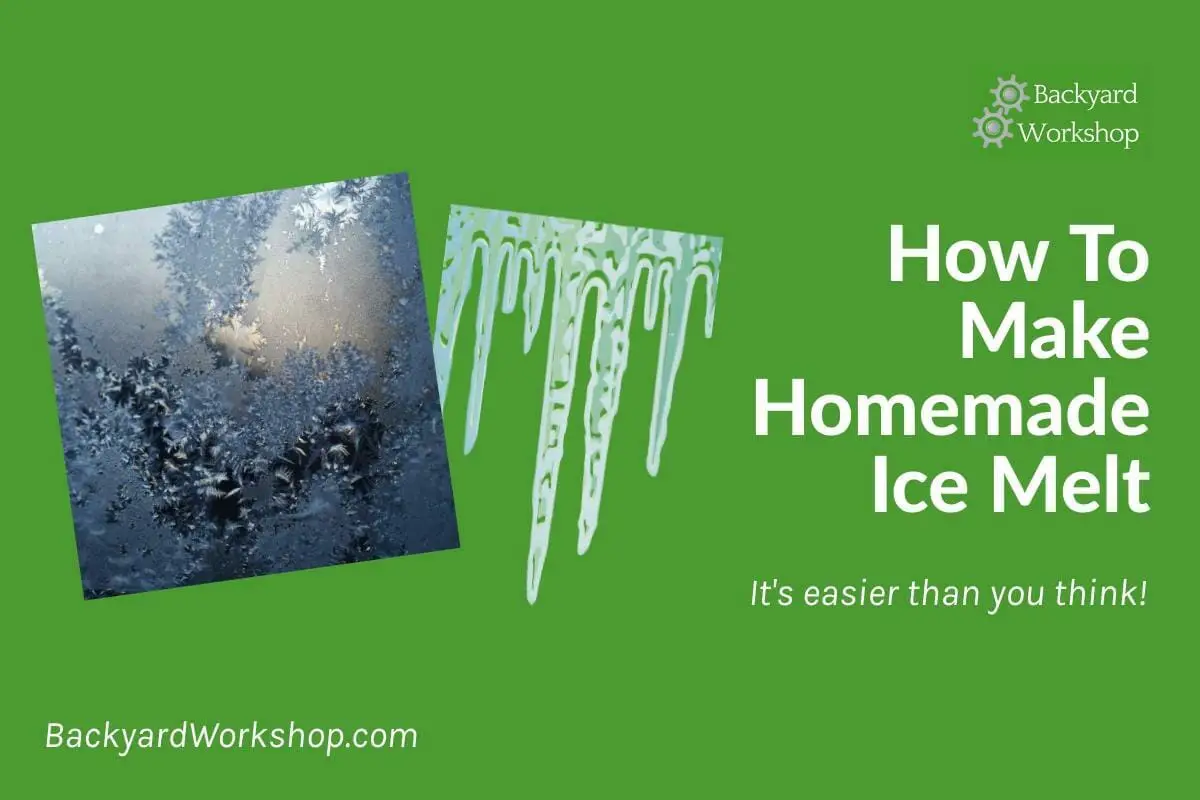How To Make Homemade Ice Melt For A Better Winter

When your driveway, steps, and sidewalks are covered with slick ice, you need a homemade ice melt remedy. If you haven’t prepared your vehicle for the snow, chances are your tires are stuck to the driveway, too, which means you can’t even drive to the shops to buy a deicer.
What is in your cupboards that will help melt the ice?
Salt and Water
The combination of salt and water will melt the ice and snow. Applying just rock salt on the ice won’t solve your dilemma. Salt lowers the freezing point of water; it doesn’t melt the ice or start the melting process. That is why you need the hot water.
Mix salt with hot water. Then pour the boiling salt water over the ice. Communities are leaning towards using the salt and water mixture because the water helps spread the salt across the area producing better results.
The salt penetrates the ice and prevents the water refreezing by lowering the water’s freezing point from 32 degrees to 15 degrees. Salt can function well all the way down to 15 degrees Fahrenheit. When the temperature dips below this threshold, the salt won’t be able to melt ice.
Although salt works on ice, it doesn’t work on pure snow. Remove as much of the top layer of snow with a shovel or snowblower before applying the salt-water mixture on the slick ice.
Rock salt from underground salt mines contains 99 percent sodium chloride. It is a coarser version of table salt. Table salt is more expensive than rock salt, but due to its finer grind, it may be more effective.
Although rock salt and table salt may be safer than certain ice-melting products you may purchase, it isn’t the most harmless homemade ice melt remedy. Use the salt and hot water mixture moderately because the salt may harm the garden plants and lawn in your backyard.
With long-term usage, it may also damage asphalt and concrete driveways and sidewalks. When the salt enters the porous and cracked surfaces of the concrete driveway, the mixture freezes at this lower temperature. The ice formed causes expansion, which leads to potholes and weakened areas, which may be dangerous to walk or drive over.
What ingredients you will need
- ½- gallon hot water
- 5-10 pounds of rock salt.
- 5-gallon bucket
Step by step instruction on how to melt the ice with salt and water
- Add rock salt in the 5-gallon bucket.
- Pour around ½-gallon of hot water into the bucket. Use up to one gallon of water if you want to spread ice-melter solution more. The more you dilute the solution, the longer it takes for the ice to melt – but then again, less salt is used to cover the surface.
- Mix so that the salt dissolves in the liquid.
- Carefully pour the solution into the icy areas. The salt slurry stops the refreezing of the ice/hot water. Spreading the salty water mixture over the surface melts the ice faster than sprinkling salt only on the ice surface.
- Once the ice melts, break it up with a shovel and remove it from your driveway or sidewalk.
- Although the salt-water recipe works to unstick tires, DON’T POUR HOT WATER ON WINDSHIELDS OR GLASS; IT MIGHT CRACK OR DAMAGE THE SURFACE.
Alternatives to salt
If you don’t have salt in the house, sugar, beet juice, or Epsom salt (magnesium sulfate) have similar properties.
Magnesium chloride or calcium chloride isn’t as destructive to plants than salt. For colder conditions, magnesium chloride is effective up to minus 13 degrees and calcium chloride to minus 50 degrees. Both are safer alternatives for concrete and asphalt surfaces.
Also Related To Homemade Ice Melt – Icy Driveway Safety Tips
What is the best homemade ice melt remedy?
Mixing ½ gallon hot water with 5-10 pounds of rock salt will melt slick ice on your driveways, sidewalks, and steps. The salt avoids ice re-freezing, and hot water melts it. Salt is a typical homemade ice melt remedy, but it doesn’t melt snow. It may cause damage to plants and concrete or asphalt driveways. There are alternative homemade remedies.
Other Methods of Melting Ice
Isopropyl alcohol / Rubbing alcohol
If the freezing point is below 15 degrees Fahrenheit and you use salt, you will end up with salty ice that didn’t melt. Isopropyl alcohol, however, has lower freezing of minus 20 degrees Fahrenheit and will work where salt is ineffective.
Make sure when purchasing rubbing alcohol that it is isopropyl alcohol. Apply the rubbing alcohol directly or mix the alcohol with water in a spray bottle.
What you need
- ½-gallon hot water
- 1 tablespoon 70-percent isopropyl alcohol
- 1 teaspoon biodegradable dish soap
- Spray bottle
How to melt the ice with alcohol
- Mix the boiling water and alcohol in a bucket.
- Add the dish soap to prevent the refreezing of the ice.
- With thick snow or freezing temperatures, increase the isopropyl alcohol to a maximum of 4 tablespoons. Alternatively, use a higher percentage of rubbing alcohol up to 91 percent.
- Pour on the ice and remove it with a shovel when melted.
Beet Juice and Water
In certain parts of the U.S. and Canada, beet juice is applied by cities to roads to deice the roads after it was pretreated with saltwater. The beet juice lowers the freezing temperature allowing the brine (saltwater) to melt the ice in colder weather.
It is less damaging to plants but may leave a red stain on concrete surfaces – and possibly cars.
What you need:
- 1 -gallon hot water
- 1 ½ cups salt
- 8 ounces beet juice
- Bucket
Apply the same way you would the rock salt and hot water recipe.
Vinegar and Water
Although vinegar and water mixture won’t melt the ice, it works better as a preventative method to avoid ice forming. Simply spray your windshield, porches or covered areas the night before you expect a snowstorm.
The acetic acid in vinegar lowers the freezing point of snow or water, which in turn avoids it from crusting or forming ice.
What you need
- 1/3 cup water
- 2/3 cup vinegar
- Bucket or spray can
How to Apply
Apply the water-vinegar the night before.
Then you won’t have to damage the windshield by scraping your windows or pouring hot water and cracking the windshield.
If you apply the recipe after the ice has formed, the result isn’t as effective as the preventative method.
Homemade Ice Melting Systems that Don’t Work
Some homemade ice melt recipes sound great but aren’t practical, have bad side effects or don’t work.
- Soy Sauce contains about a fifth of sodium compared to salt. It may work for light ice in warmer temperatures, but the salt content is too low for melting ice.
- Baking soda contains ½ the amount of sodium than salt, which makes it less effective. The more diluted the salt, the less it works. If you can use salt, why go for weaker alternatives like baking soda or soy sauce?
- Isopropyl alcohol can kill your grass. Other types of alcohol, however, aren’t as effective.
- Ammonium sulfate in fertilizers lowers the temperature that the ice melts. It is a homemade ice melt remedy to use on grass and garden areas. When spread on sidewalks and driveways, however, it isn’t environmentally-friendly because the melted ice may wash the fertilizer into the municipal sewer and water system.
Conclusion
To avoid people slipping on the slick ice, lay down sand, fireplace ash, or kitty litter to add friction to the surface. Straw, gravel, and woodchip will also provide traction. When the surface refreezes, it may give some grip enabling you to walk on the ice.
Be mindful, however, not to leave tracks of dirt when going indoors.
What home ice melt solution do you use and which ones didn’t work for you?

